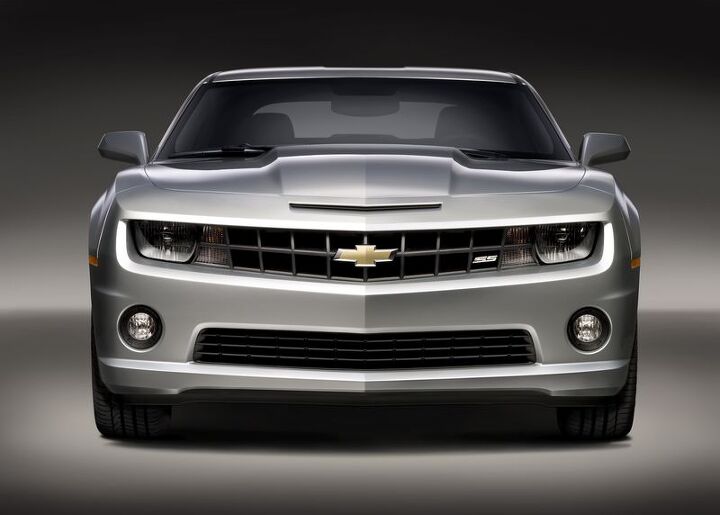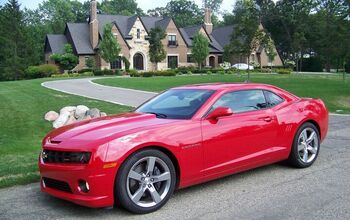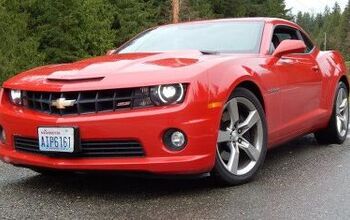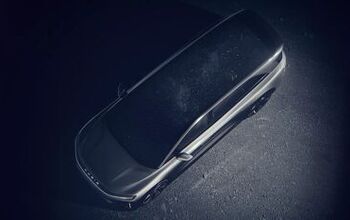Review: 2010 Chevrolet Camaro SS/RS

One of the least publicized aspects of the “New” GM is how much of the old company remains on the books. More to the point, bad ideas with new window dressings still reign (Cutlass) supreme. But not the new 2006—sorry, 2010—Chevrolet Camaro: this idea had the right stuff. On paper. In the real world?
The interior reeks and creaks of GM interior’s stock and trade: look for visual pleasure, yet touch for sensory disapproval. Aside from stitched armrests on the SS’ door panels, Camaro occupants sit between a rock and a hard place. Faux silver trim accents the flimsy vent registers on a brittle dashboard, then encompass the area normally associated with cloth/vinyl padding on the door panels. (Even the Chevrolet Aveo got that right.) Sitting in the Camaro’s cramped rear cubby reinforces the impression. The interior is awash in a blandness that would not feel out of place in a Chrysler Sebring. What happened to the world-class interiors you promised, Mr. Lutz?
That’s not to say the Camaro’s interior can’t be fun. The busy analog gauges sit in retro square binnacles, while secondary readouts rest atop the console, with its pitch-perfect short handle shifter. The SS gets an ergonomic steering wheel complete with an M-series worthy logo on the bottom of the tiller. There’s a respectable Boston Acoustics audio system and the seats aren’t half bad . . . unless you try the thrones in a Dodge Challenger SRT-8.
But Camaro interiors have been crap for years. The spatial challenge never dissuaded the Bowtie faithful for one reason: Chevy’s small block V8. With six smooth-shifting, close-ratio speeds and a burly 6.3 liters and 422hp of LS3 underfoot, the SS’s performance is absolutely right for the nameplate. Aside from the (industry standard) practice of throttle delay at tip-in, the Camaro’s power is effortless, refined and angry enough to ruin an import’s day, one quarter-mile at a time. We’re torquing the mid-to-low 13 second range—much like the outgoing Camaro SS and its low-po LS1 mill.
All of this makes sense, given the fifth-generation Camaro’s portly underpinnings. Blessed with plenty of NVH (noise, vibration, harshness) reducing materials, an independent rear axle and the necessary bulk associated with the Zeta Platform, the 3800lb Camaro SS rides like a champ, obliterating any bump in the road, rolling down the highway like a refined German autobahn cruiser. Pony car heritage be damned, the new Camaro is made for Baby Boomers who remember the good ol’ days, but demand Lexus-like refinement in the prime of their lives.
Aye, there’s the rub. The Chevrolet Camaro still wanders like a lost Taliban in the Tora Bora; angry and full of vigor, but without any focused direction. No longer a Panhard-infused, knuckle-dragging back road barnstormer, the new Camaro has enough inertia-infused body roll to feel like an overstuffed gymnast in quick corners. The multi-branded Camaro/Brembo calipers have a Bumblebee-like identity crisis, but they stop like a Decepticon in Optimus Prime’s wake, sans nose-dive.
The fifth generation Camaro’s marketing push in the “new” GM’s portfolio notwithstanding, it appears the remnants of the old GM are alive and well. Uh-oh. If the latest Camaro was a clean sheet redesign, GM wouldn’t give the Zeta platform the time of day. It’s simply too big and heavy to provide the lively performance associated with the Camaro brand. Sorry, model. Even if GM’s platform engineers got the right bones for the beast, the crap interior proves that the “new” GM isn’t ready for the change that customers, taxpayers and the American economy expect from a company (supposedly) changing its ways.

More by Sajeev Mehta
Latest Car Reviews
Read moreLatest Product Reviews
Read moreRecent Comments
- Redapple2 Love the wheels
- Redapple2 Good luck to them. They used to make great cars. 510. 240Z, Sentra SE-R. Maxima. Frontier.
- Joe65688619 Under Ghosn they went through the same short-term bottom-line thinking that GM did in the 80s/90s, and they have not recovered say, to their heyday in the 50s and 60s in terms of market share and innovation. Poor design decisions (a CVT in their front-wheel drive "4-Door Sports Car", model overlap in a poorly performing segment (they never needed the Altima AND the Maxima...what they needed was one vehicle with different drivetrain, including hybrid, to compete with the Accord/Camry, and decontenting their vehicles: My 2012 QX56 (I know, not a Nissan, but the same holds for the Armada) had power rear windows in the cargo area that could vent, a glass hatch on the back door that could be opened separate from the whole liftgate (in such a tall vehicle, kinda essential if you have it in a garage and want to load the trunk without having to open the garage door to make room for the lift gate), a nice driver's side folding armrest, and a few other quality-of-life details absent from my 2018 QX80. In a competitive market this attention to detai is can be the differentiator that sell cars. Now they are caught in the middle of the market, competing more with Hyundai and Kia and selling discounted vehicles near the same price points, but losing money on them. They invested also invested a lot in niche platforms. The Leaf was one of the first full EVs, but never really evolved. They misjudged the market - luxury EVs are selling, small budget models not so much. Variable compression engines offering little in terms of real-world power or tech, let a lot of complexity that is leading to higher failure rates. Aside from the Z and GT-R (low volume models), not much forced induction (whether your a fan or not, look at what Honda did with the CR-V and Acura RDX - same chassis, slap a turbo on it, make it nicer inside, and now you can sell it as a semi-premium brand with higher markup). That said, I do believe they retain the technical and engineering capability to do far better. About time management realized they need to make smarter investments and understand their markets better.
- Kwik_Shift_Pro4X Off-road fluff on vehicles that should not be off road needs to die.
- Kwik_Shift_Pro4X Saw this posted on social media; “Just bought a 2023 Tundra with the 14" screen. Let my son borrow it for the afternoon, he connected his phone to listen to his iTunes.The next day my insurance company raised my rates and added my son to my policy. The email said that a private company showed that my son drove the vehicle. He already had his own vehicle that he was insuring.My insurance company demanded he give all his insurance info and some private info for proof. He declined for privacy reasons and my insurance cancelled my policy.These new vehicles with their tech are on condition that we give up our privacy to enter their world. It's not worth it people.”





































Comments
Join the conversation
I finally sat in a new Camaro a couple of days ago. There was enough headroom for me to sit up straight, but if I leaned forward a few inches my head hit the roof. And I'm not even that tall (6'2".) And the visibility to the back was awful. The windows are really nothing more than opera windows. That being said, the car is beautiful and has great performance and is a good value. It's just a tragedy that the visibility and headroom is so poor. Looks like I'll have to enjoy the new Camaro from a distance.
Being myself, I think any Camaro after 1982, should have been used for running cocaine, and nothing more. After all, that was their fate, wasn't it? Although the Iroc-Z was actually said to be a good engine, I'm not sure if I'd have faith in the whole car. From 1970, to 1979, however, was the prime of it's life. The genes of that decade really show in that front it. Not sure if "bulldog" is an appropriate description. To me, the 1969 Camaro, accept for the famed Yenko/SC, isn't appealing to me. Being that, all GM body styles were the same. Take a look at the Firebird of 1969, it's just a Camaro with a horizontal split in the tailights, and a snap on "V" to the front grill. Needless to say, I wouldn't buy this car. But if I were to buy a Camaro, I think it's obvious which decade I would choose. No pony for me, although I am a huge fan of the Dodge Challenger, but not much else from Chrysler.